Development of Whole Potato Flour Fish Noodles
Weixin WANG Qingqin CHEN Peng WU Jianfeng ZHAN Ting HU Junfeng SHEN Yimin WANG
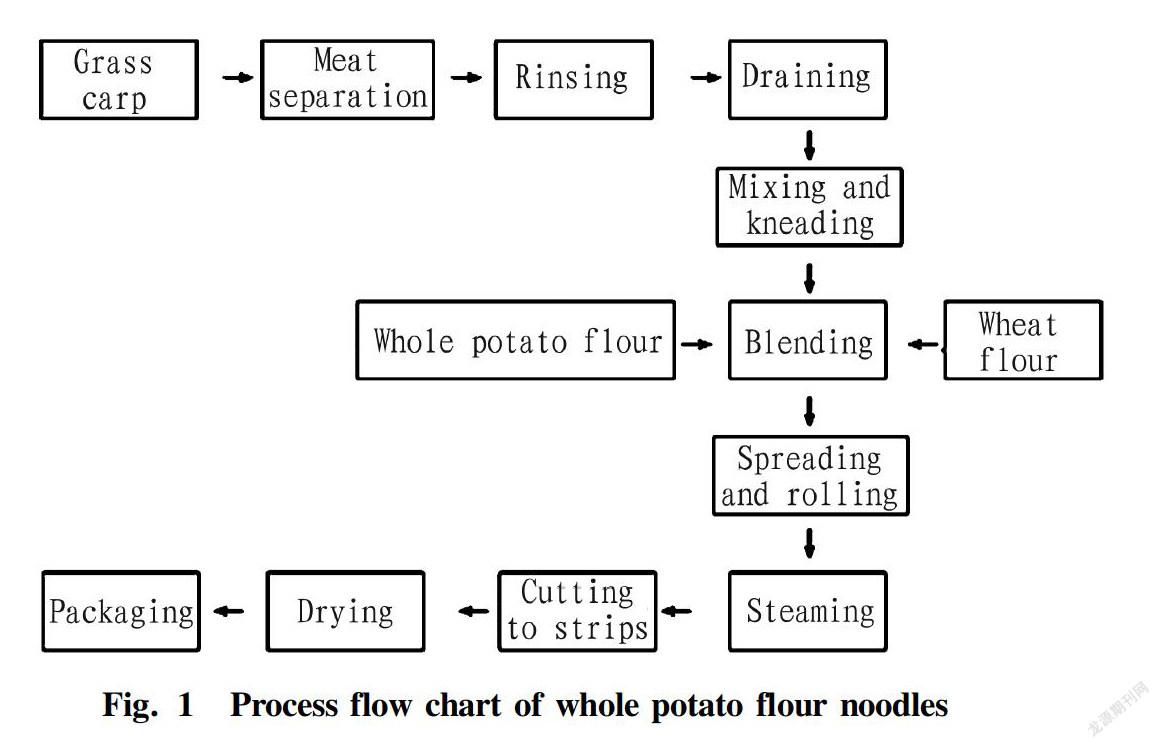
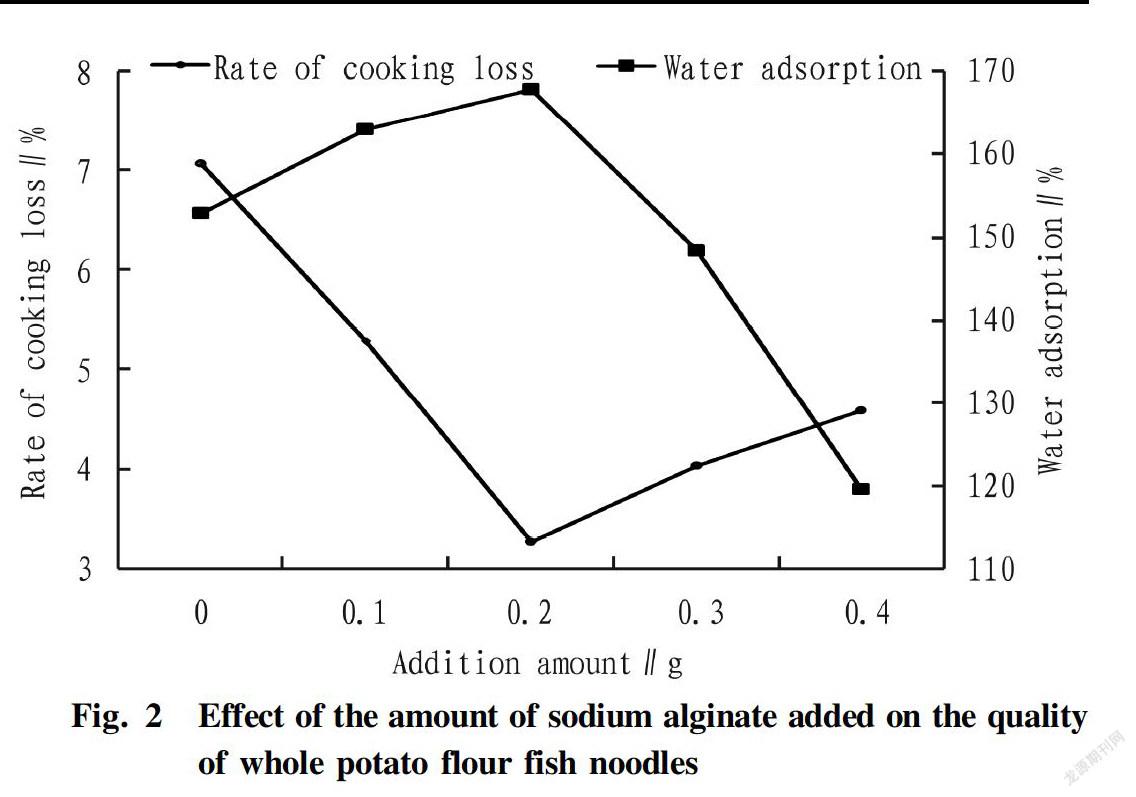

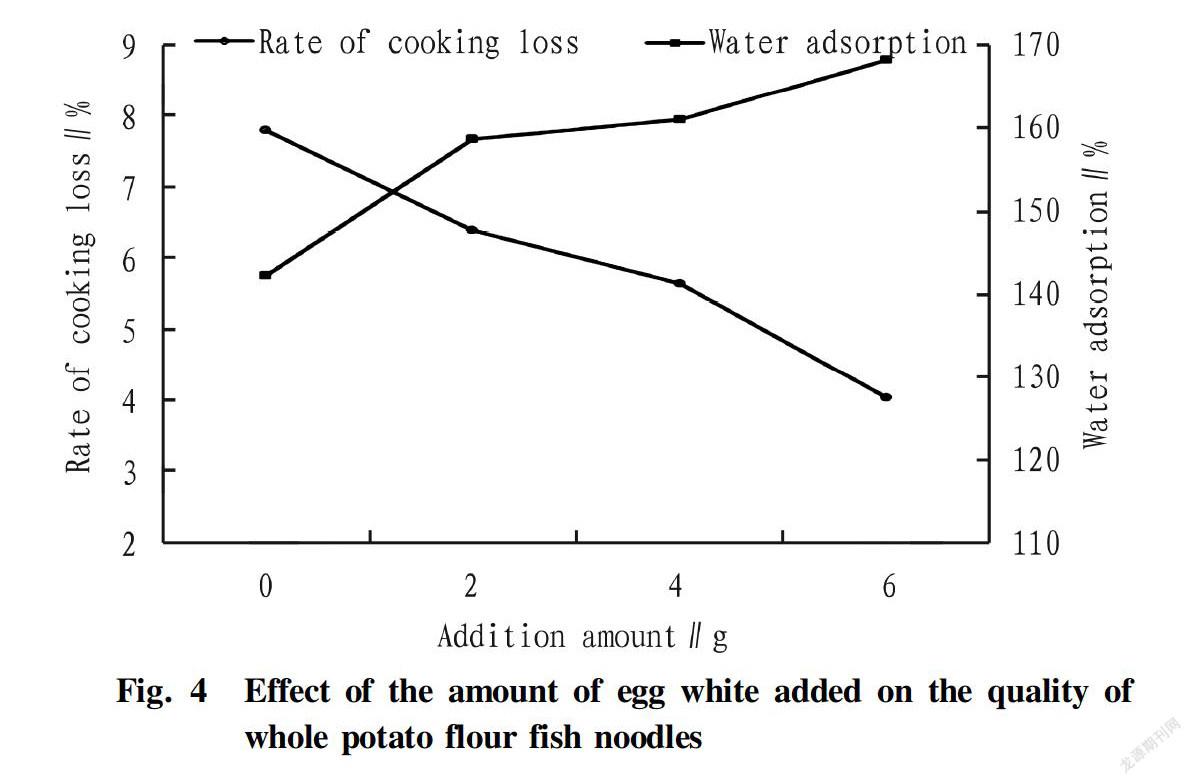
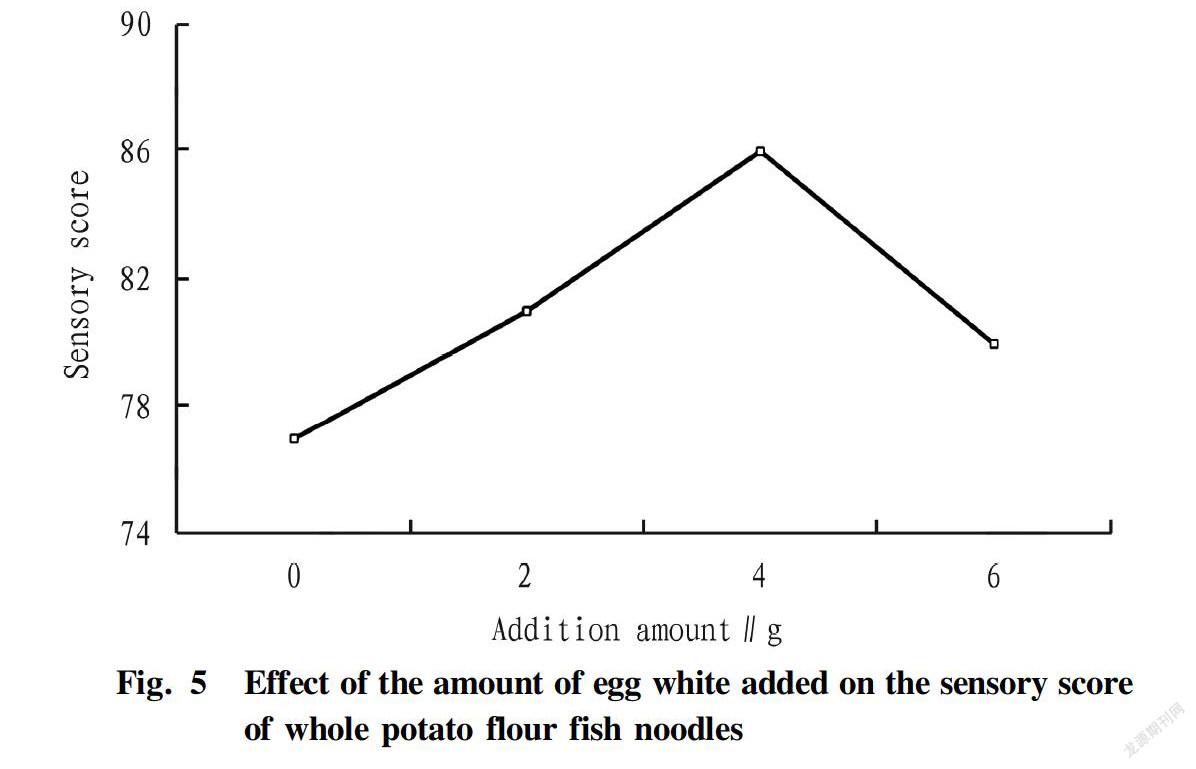

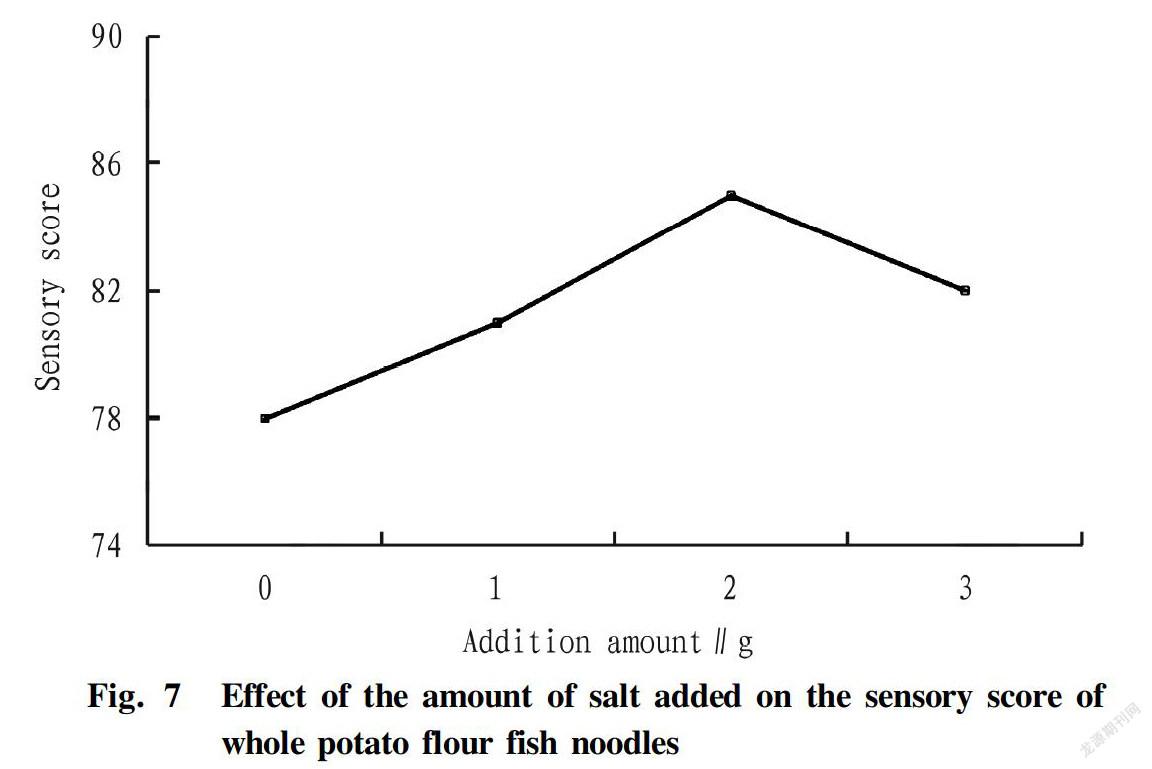






Abstract [Objectives] This study was conducted to prepare a kind of traditional aquatic food―fish noodles in Hubei Province by replacing some wheat flour with whole potato flour.
[Methods] With whole potato flour, wheat flour and minced fish as main raw materials, the effects of the ratio of whole potato flour to minced fish and the addition amounts of sodium alginate, egg white, salt and ginger juice on the quality of whole potato flour fish noodles were studied. An orthogonal experiment was conducted to confirm the optimal technical formula of the whole potato flour fish noodles.
[Results] The best formula of the whole potato flour fish noodles was whole potato flour 30 g, wheat flour 20 g, minced fish (grass carp) 50 g, salt 2.00 g, egg white 4.00 g, sodium alginate 2.00 g, and ginger juice 5.00 g.
[Conclusions] The whole potato flour fish noodles prepared according to this formula are not only nutritious and taste good, but also have the advantages of easy and convenient eating and storage. This kind of fish noodle has good development prospects.
Key words Whole potato flour; Fish noodle; Orthogonal experiment
Received: August 12, 2019Accepted: November 6, 2019
Weixin WANG (1976-), female, P. R. China, associate professor, PhD, devoted to research about agricultural Product Processing.
*Corresponding author. Email: wangweixin1009@aliyun.com.
China is a big freshwater fishery country with extremely rich freshwater fish resources. According to China Fishery Statistical Yearbook 2019, the total output of freshwater fish culture in China reached 25 542.8 thousand tons in 2018, but the processing capacity of freshwater fish is still less than 15% of the freshwater fish raising quantity. Therefore, the development of effective processing methods has become an urgent task for the sustainable and healthy development of freshwater fisheries in China. Fish noodle is one of the traditional aquatic products in Hubei Province. It is generally made of minced fish, flour, starch, water, salt, etc., through the procedures of dough kneading and noodle forming. It has the characteristics of unique flavor and rich nutrition, and is very popular among consumers at home and abroad[1-3].
Potatoes are known as "perfect" nutritional products, rich in dietary fiber, low in fat, which help control weight gain and prevent high blood pressure, high cholesterol and diabetes[4-6]. In 2015, the Ministry of Agriculture of China listed the potato as the fourth largest staple food following corn, wheat and rice. Potato in China has a single method of consumption, and whole potato flour is one of the dehydrated potato products. Using whole potato flour as a raw material, it can be added with corresponding nutrients in scientific formula, and made into a variety of convenient foods.
In response to developing potato as a staple food in China, we developed a new type of nutritious fish noodles using nutrientrich whole potato flour and freshwater fish as main raw materials, which can enrich the fish noodle variety and provide reference for deep processing and utilization of freshwater fish and developing potato as a staple food.
Materials and Methods
Experimental materials
Grass carp: purchased in Huangshang Supermarket, Huanggang City; whole potato flour: Chengde Jingbo Trading Co., Ltd.; highgluten wheat flour: Hebei Jinshahe Flour Industry Co., Ltd.; sodium alginate, salt, ginger, eggs: commercially available, food grade, in line with national health quality requirements.
Experimental methods
Production process of whole potato flour noodles
The flow chart of the production process of whole potato flour noodles is shown as below.
Pretreatment: The fish scales, head, fish skin and internal organs of grass carp are removed, and the blood, black film and other debris in the abdominal cavity of grass carp are flushed away with running water. The water temperature should not exceed 25 ℃, otherwise it will affect the quality of grass carp.
Meat separation: The fish bones and the red grass fish flesh are excluded. The red fish meat will affect the color of the potato flour, which will reduce the quality of the product.
Rising: The collected grass carp flesh is soaked twice in 5-10 times of ice water for 10-15 min, and for the third time of soaking, 0.3% salt is added. Weak brine is used to rinse the fish flesh to whiten the fish flesh, remove the fishy smell and accelerate dehydration.
Filtration: The grass carp is filtered with clean gauze.
Mixing and kneading: The grass carp is first kneaded without any additives, until the fish flesh become a viscous paste, which has certain gloss on the surface, and is fine smooth and not rough when felt with hands, and can be extruded into small dumplings which are smooth on the surface and has certain elasticity. Then, various additives can be added, followed by kneading.
Blending and aging: In the process of the actual kneading, when adding the whole potato flour and the wheat flour, the two should be added in small quantities in multiple times, and it is necessary to continuously mix and stir them evenly. The dough has a smooth surface and certain elasticity. The kneaded dough is stood for about 10 min until the dough is aged, elastic and sticky.
Spreading and rolling: On a clean operation table, a little starch is sprinkled, so that the starch is evenly scattered on the operation table, and the aged dough is placed on it, and repeatedly pressed with a rolling pin to make it a smooth and elastic dough piece, which is then rolled up.
Steaming and slitting: The rolled noodles were steamed in a steaming pot and steamed for 30 min. The steamed rolled dough piece was taken out, cooled to 40 ℃, and cut to strips with a thickness of about 1 cm.
Drying: It was dried at a high temperature of 80 ℃ for 160 min.
Determination of the quality of whole potato flour noodles
Determination of rate of cooking loss[7-8]: Ten whole potato flour fish noodles were weighed. The weighed noodles were put into 200 ml of boiling water and cooked at 98-100 ℃ for the best cooking. The cooked noodles were filtered with a strainer, and the fish noodle soup was boiled to about 50 ml and dried in an oven at 105 ℃ to constant weight. Then, the cooking loss rate was calculated accordingly. Three parallel experiments were done.
Rate of cooking loss (%)=(M1/M2)×100%
Wherein M1 is the dry mater weight of the whole potato flour fish noodle soup, g; and M2 is the dry weight of the whole potato flour fish noodles, g.
Determination of water absorption of noodles[7]: Ten whole potato flour fish noodles were weighed. The weighed noodles were put into 200 ml of boiling water and cooked at 98-100 ℃ for the best cooking. The cooked noodles were fished out with a strainer and placed on filter paper, and the water was drained for 5 min. The whole potato flour fish noodles were quickly transferred to a beaker that had been dried to constant weight. The noodles and beaker were weighed together using an analytical balance.
Water absorption (%)=(G-M2)/M2×100%
Wherein M2 is the dry weight of whole potato flour fish noodles, g; and G is the weight of the cooked whole potato flour fish noodles, g.
Sensory evaluation of whole potato flour noodles: The sensory evaluation is shown in Table 1.
Determination of whole potato flour noodle fish formula
Effect of main raw material ratio on the quality of whole potato flour fish noodles: Whole potato flour fish noodles were prepared by mixing whole potato flour and minced fish with ratios of 80∶20, 70∶30, 60∶40, 50∶50, 40∶60, 30∶70 and 20∶80, respectively. According to the formation of fish noodles, the ratio of the two was initially determined. Further tests were conducted, and 50% of minced fish was selected. The ratios of whole potato flour to wheat flour were set to be 50∶0, 40∶10, 30∶20, 20∶30, and 10∶40, and the suitable ratio of the two was determined from them by sensory evaluation.
Effect of sodium alginate addition on the quality of whole potato flour fish noodles: With whole potato flour, wheat flour and minced fish fixed at 30, 20 of and 50 g, respectively, the addition amounts of sodium alginate were designed to be 0.00, 0.10, 0.20, 0.30, and 0.40 g, respectively. And the suitable addition amount of sodium alginate was determined by the rate of cooking loss and water absorption and sensory evaluation.
Effect of egg white addition on the quality of whole potato flour fish noodles: With whole potato flour, wheat flour and minced fish fixed at 30, 20 of and 50 g, respectively, the total amounts of egg white were set to be 0.00, 2.00, 4.00 and 6.00 g, respectively. And the suitable addition amount of egg white was determined by the rate of cooking loss and water absorption and sensory evaluation.
Effect of salt addition on the quality of whole potato flour fish noodles: With whole potato flour, wheat flour and minced fish fixed at 30, 20 of and 50 g, respectively, the addition amounts of salt were set to be 0.00, 1.00, 2.00 and 3.00 g. And the suitable addition amount of salt was determined by the rate of cooking loss and water absorption and sensory evaluation.
Effect of ginger juice on the quality of whole potato flour fish noodles: With whole potato flour, wheat flour and minced fish fixed at 30, 20 of and 50 g, respectively, the addition amounts of salt were set to be 0.00, 2.00, 4.00, 6.00 and 8.00 g. And the suitable addition amount of ginger juice was determined by sensory evaluation.
Orthogonal test: With whole potato flour, wheat flour and minced fish fixed at 30, 20 of and 50 g, respectively, sodium alginate, egg white, salt and ginger juice were subjected to orthogonal test according to the L9 (34) orthogonal experiment (Table 1), and the quality was evaluated to determine the optimal formula.
Results and Analysis
Effect of main raw material ratio on the quality of whole potato flour fish noodles
The formula of the whole potato flour fish noodles directly determines the quality of the whole fish flour fish noodles. In the process of making whole potato flour fish noodles, dough No. 2 can be rolled flat, but cannot be rolled up; No. 6 tasted hard; and after No. 7 was steamed, the surface of the fish noodles was not smooth. It can be seen from Table 3 that with the amount of whole potato flour decreasing and the amount of minced fish increasing, the sensory score first rose and then decreased. When the total amount of potato flour added was less than 50 g and the amount of minced fish added was greater than 50%, the sensory score decreased. Comprehensively, whole potato flour and minced fish were both determined to be 50 g.
Since the whole potato flour is dark, wheat flour was appropriately added to adjust the color of the fish noodles. As can be seen from Table 4, with the decrease of the total amount of potato flour and the increase of wheat flour, the sensory score gradually increased. When the potato flour was reduced to 30 g and the wheat flour was increased to 20 g, the increase in sensory score tended to be flat. Therefore, the whole potato flour and wheat flour amounts were selected as 30 and 20 g, respectively.
Agricultural Biotechnology2019
Effect of the amount of sodium alginate added on the quality of whole potato flour fish noodles
Sodium alginate is a hydrophilic polymer with strong hygroscopicity, and can form a viscous colloidal gel when dissolved in water[9]. Sodium alginate has a good improving effect on the quality of whole potato flour fish noodles, which not only enhances the water absorption of dough, but also enhances the hardness and elasticity of fish noodles and reduces breaking. It can be seen from Fig. 2 that with the increase of the amount of sodium alginate added, the rate of cooking loss in the whole potato flour fish noodles first decreased and then increased, and the trend of water absorption was first increasing and then decreasing. It can be seen from Fig. 3 that the sensory score of the whole potato flour fish noodles showed that the sensory score increased with the addition of sodium alginate, but when the amount was more than 0.2 g, the sensory score showed a downward trend. Therefore, comprehensibly from the total rate of cooking loss, water absorption and sensory score, the amount of sodium alginate added was selected to be 0.2 g.
Effect of the amount of egg white added on the quality of whole potato flour fish noodles
Adding a right amount of egg white can improve the quality of fish noodles, but adding too much will cover up the flavor of whole
potato flour fish noodles, which makes the texture of whole potato flour fish noodles of the potato aged. This is because egg white contains collagen, and a right amount of egg white can increase the elasticity and chewiness of fish noodles, but too much will make fish noodles too hard when tasted, that is, the fish noodles is getting aged. It can be seen from Fig. 4 that egg white had a certain improving effect on the quality of the whole potato flour fish noodles. With the increase of the amount of egg white added, the rate of cooking loss of the whole potato flour fish noodles showed a downward trend, and the water absorption showed an increasing trend. As can be seen from Fig. 5, egg white also had a certain influence on the sensory score. With the increase of the amount of egg white added, the sensory score increased accordingly. However, when the egg white was more than 4 g, the fish noodles were too hard and hard to chew, and the score was thus on the decrease. Comprehensively, 4 g was selected from color, quality, sensory score and cost.
Effect of the amount of salt added on the quality of whole potato flour fish noodles
The addition of salt can not only affect the taste of the whole potato flour fish noodles, but also affect can affect its cooking quality. The effect of adding salt can make fish noodles gelate, and after adding a proper amount of salt, kneading fish flesh into minced fish and heating the fish flesh, the muscle fibrin is expanded into a fibrous shape and form a highviscosity sol state after stirring. And after shaping, due to thermal deformation and the interaction between protein molecules such as SS binding and hydrogen bonding, a network structure is formed. The network structure closes free water in the network, so the formed gel has good elasticity[10]. It can be seen from Fig. 6 that with the increase of the amount of salt added, the effect of salt on the water absorption of the whole potato flour fish noodles was not obvious, but the rate of cooking loss first decreased and then increased. It can be seen from Fig. 7 that the amount of salt also affected the sensory score. With the amount of salt added increasing, the sensory score also increased. When the amount of salt added was 0-1 g, the salinity is not enough, the chewiness was not good, and the taste was not as good as when 2-3 g of salt was added. It was comprehensively assessed that the total amount of salt added was preferably between 2 and 3 g. However, people are now biased towards low salt requirements. Finally, the total amount of salt added was selected to be 2 g.
Effect of the addition amount of ginger juice on the quality of whole potato flour fish noodles
Ginger is the rhizome of Zingiberaceae plants. It is a perennial plant. Its tuber is flat and irregular, and has fingerlike branches. The surface is yellowwhite or graywhite, and has a fragrant and spicy taste. Ginger contains many ingredients such as proteins, fat, carbohydrates, as well as calcium, phosphorus, iron and various vitamins[11].
The ginger juice used in this study was made from ginger and purified water at a ratio of 1∶1. Ginger juice is warm in nature, and its aroma components include shogaol, gingerol, zingerone, camphene and other dozens of aromatic substances[12], which cannot only remove the fishy smell, but also gives the whole potato flour fish noodles a special flavor.
As shown in Table 5, as the amount of ginger juice added increased, the fishy taste gradually faded and the score increased. However, when the addition amount was greater than 6 g, the scored decreased slightly, which was probably because the spicy taste of ginger juice covered some unique delicate flavor of minced fish beside covering the fishy odor. Therefore, it was preliminarily determined that the amount of ginger juice added should be 4 g.
Orthogonal experiment
It can be seen from Table 6 that the order of the factors affecting the whole potato flour fish noodles was salt>egg white>sodium alginate>ginger juice, and the best combination of ingredients was A2B2C2D3, i.e., sodium alginate 0.20 g, egg white 4.00 g, salt 2.00 g, ginger Juice 5.00 g. The results of the verification experiment showed that the sensory score of the formula was better than that of any group of the orthogonal experiment, which was 91 points, which achieved the expected optimization test results.
Conclusions and Discussion
It was determined in this study that the best formula of the whole potato flour fish noodles was whole potato flour 30 g, wheat flour 20 g, minced fish (grass carp) 50 g, salt 2.00 g, egg white 4.00 g, sodium alginate 2.00 g, and ginger juice 5.00 g. The potato fish noodles not only enrich the variety of traditional fish noodles, but also provide a reference for the study of developing potato into a staple food—the fourth major staple food.
References
[1] HE XY, ZENG X. Material ratio of Yunmeng Pueraria powder fishnoodles[J]. Food Science and Technology, 2014(10): 129-132. (in Chinese)
[2] FAN WY, ZHANG J, LIN H, et al. Study on processing technology for nutritional and flavor fish noodles from Cynoglossus[J]. Science and Technology of Food Industry, 2010(7): 217-218. (in Chinese)
[3] LI RJ. Study on traditional fish noodle processing technology and storage stability[D]. Wuhan: Huazhong Agricultural University, 2009. (in Chinese)
[4] ZHAO FM, LI SJ, ZHANG XY, et al. Nutritional evaluation of amino acids in different potato cultivars[J]. Journal of The Chinese Cereals and Oils Association, 2014(9): 13-18. (in Chinese)
[5] WANG L, LUO HX, LI SR, et al. Review on processing and utilization of potato starch, protein and whole powder[J]. Journal of the Chinese Cereals and Oils Association, 2017(3): 141-146. (in Chinese)
[6] HOU FN, MU TH, SUN HN, et al. Nutritional quality evaluation of proteins in different potato whole powder[J]. Food Science and Technology, 2015(3): 49-56. (in Chinese)
[7] HONG YANG, JAE W·PARK. Effects of starch properties and thermalprocessing conditions on surimistarch gels[J]. Lrbensm.Wiss.u.Techmol. 1998(31): 344-353. (in Chinese)
[8] SHI JL, WEI YM, GUO BL, et al. Study on the evaluation method of noodle eating quality[J]. Journal of Northwest A&F University: Social Science Edition, 2002, 30(6): 111-117. (in Chinese)
[9] SHI JL, WEI YM, ZHANG GQ, et al. Effect of wheat protein and starch on microstructure of noodle products[J]. Journal of Triticeae Crops, 2000, 20(4): 72-74. (in Chinese)
[10] CUI GY, ZHANG H, ZHANG H, et al. Analysis of nutritional components and evaluation of edible quality of potato rice flour[J]. The Food Industry, 2016(10): 55-60. (in Chinese)
[11] GAO CM, LIU MZ, LYU SY, et al. Preparation of sodium alginate hydrogel and its application in drug release[J]. Progress in Chemistry, 2013(6): 1012-1022. (in Chinese)
[12] ZHANG SL. Ginger juice in cooking applications[J]. Food Engineering, 2009(3): 18-20.
- 农业生物技术(英文版)的其它文章
- Observation on Cardiac Opening of the Inferior Vena Cava in Goat Fetuses
- Evaluation on Application and Spraying Effect of AirAssisted Sprayer in Apple Orchard with Dwarfing Rootstocks
- Problems in the Development of Traditional Chinese Medicinal Materials Planting Industry in Shiyan City and Countermeasures
- Study on Practical Mature Age of Individual Pinus thunbergii×P. densiflora
- Effects of Different Densityreducing Methods on Canopy Microenvironment, Tree Growth and Fruit Quality in Closed Apple Orchard
- Preparation of Alkalisoluble Pachymaran Rice Wine

